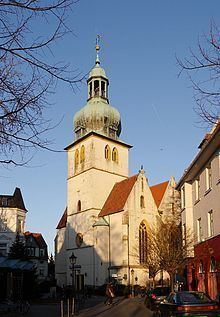Admin. region Detmold Founded 789 Area 78.95 km² Local time Friday 7:37 AM | District Herford Elevation 56-240 m (−731 ft) Population 64,088 (31 Dec 2010) | |
 | ||
Weather 5°C, Wind W at 13 km/h, 88% Humidity University University of Church Music of the Protestant Church of Westphalia | ||
Herford ( [ˈhɛɐ̯fɔɐ̯t]) is a town in North Rhine-Westphalia, Germany, located in the lowlands between the hill chains of the Wiehen Hills and the Teutoburg Forest. It is the capital of the district of Herford.
Contents
- Map of Herford Germany
- Geographic location
- Sports
- Neighbouring towns
- History
- Sights
- Museums
- Music and theatre
- Events at regular intervals
- Military
- Twin towns sister cities
- Born in Herford
- References
Map of Herford, Germany
Geographic location
The former Hanseatic town of Herford is situated in the chain of hills south of the Wiehen Hills (Ravensberg Hills). The highest place is the Dornberg (240 m) in the Schwarzenmoor district; the lowest point (56 m) is located in the Werretal in the Falkendiek district. The River Aa joins the river Werre in the centre of the town. The Stuckenberg is located east of the town.
Sports
The Herforder Ev (Ice Dragons) play in the regionaliga and have been a regular winning team. They draw an average of 800 fans.
Neighbouring towns
History
The town was founded in 789 by Charlemagne in order to guard a ford crossing the narrow Werre river. A century later, Matilda, daughter of Theudebert, duke of Saxony, grew up in the abbey of Herford; she was a descendant of the Saxon leader Widukind. In Herford she met Henry the Fowler, who later became king of Germany.
In late medieval times Herford was a member of the Hanseatic League. It was a Free Imperial City, i.e. it was directly subordinated to the emperor. This status was lost after the Peace of Westphalia (1648), when Herford was annexed by Brandenburg-Prussia. It was administered within the Province of Westphalia following the Napoleonic Wars, and made part of the new state North Rhine-Westphalia after World War II.
Sights
Museums
The MARTa Herford, a museum for contemporary art and design, housed in a building designed by Frank Gehry, has been open to the public since May 2005. Its exhibits change regularly. The current artistic director is Roland Nachtigäller.
The Daniel-Pöppelmann-Haus in Herford explores the history of the city, and the Memorial and Meeting Place Cell Block, in the basement of the city hall, documents the persecution and the obliteration of minorities. Plans to construct a museum of city history next to the city hall and the Minster church have been postponed.
Music and theatre
Herford is the seat of the Nordwestdeutsche Philharmonie (Northwest German Philharmonic) which performs regularly in the Stadtpark Schützenhof as well as many neighbouring cities in North Rhine-Westphalia. Eugene Tzigane is the principal conductor designate (2010–present). The current director is Andreas Kuntze.
The Stadttheater (Municipal theatre) provides seats for 706 viewers and it is served by visiting theatre companies.
Events at regular intervals
Military
Herford was the location of the headquarters of the 1st (United Kingdom) Armoured Division at Westfalen Garrison, part of British Forces Germany, until the division moved to the United Kingdom in 2015.
The British Forces Broadcasting Service (BFBS) studio for Germany was located in Wentworth Barracks until 2009 when it moved to Hohne.
Twin towns – sister cities
Herford is twinned with:
City-friendships include:
